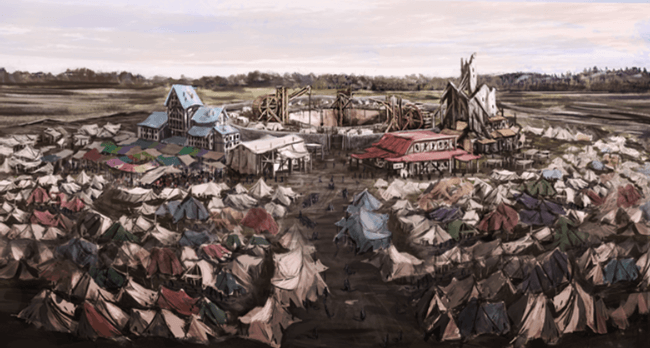Stephan Hornick
Community Goblin & Master of the Archive
Platinum WoA
Wizard of Story
Wizard of Combat
Borderland Explorer

The Problem With Maps
From JohnnFour | Published May 2, 2022Roleplaying Tips Newsletter #1,200
A Brief Word from Johnn
Today I have some tips for when players get distracted by your beautiful maps and don't pay attention to your encounter details.In addition, I have a couple of Wizard of Adventure updates for members:
Zoom Recording With Encounter Workshop
Saturday's Zoom call recording is up. Available to Silver+ Wizards. This call also contains a full tutorial on how to polish boring encounters using four of my techniques:
The 5Ps (People, Places, Pieces, Predicaments, and Perils)
The 4Cs (Conflicts, Constraints, Costs, Consequences)
Encounter Paths
The 5 Actions (Parley, Trick, Discover, Combat, Avoid)
We took a boring encounter at random and created several elements using these techniques to make it far more interesting as an example of what you can do with any encounters you worry will land flat.
Free Course on How to Use Roll20
On the weekend I also posted a wonderful course from Wizard of Adventure @Nemsoli: From 0 to 20 with Roll20. This series of videos will walk you through getting started with Roll20 and on to mastering it.
The course is no-charge and only requires a free account registration at my Campaign Community forum.
Become a Roll20 master here.
That's it for the news. Let's move on to The Problem With Maps and some tips from your fellow RPT GMs.
Have a game-full week!
— Johnn

A good friend asked me on Discord the other day about keeping players' imaginations and curiosity engaged:
One thing I’ve noticed about my VTT games is a tendency for it to devolve towards video-game or wargame.
All attention is focused on the map and tokens.
Especially when there’s such nice maps available.
In general, I like having pictures and visualizations, even for non-combat scenes if I can.
But it seems like there is not much incentive to investigate, search, explore when there’s already a picture….
VTT GM: Shows detailed picture of room. “There’s broken furniture and a rotting desk.”
Player: I open the door to the south.
Any thoughts on how to bring back more narrative exploration so players are asking questions instead of just moving tokens?
Great question. Thank you.
I feel this isn't just a VTT problem.
As game companies turn out amazing props and game aids for face-to-face gaming, it's the same thing.
What used to be a gummy bear for the fighter is now a full-colour, professionally painted 2D or 3D mini.
Prefab maps or projected maps, railroad adventures, cell phone distractions...all of these cause us to pay less attention to the imagination aspect of our games, which I believe is the most important.
I highly recommend Scott McLoud's book, Understanding Comics (affiliate link), for thoughts on how much detail is too much for ruining the imagination.
Some Tips on Keeping Players Engaged
So let's take "get rid of all the fancy stuff" off the table. Pun intended.
Some GMs love the beautiful VTT maps and the cool props and aids available.
What else can we do?
Some thoughts:
1. Use Scene Art Instead of Battle Maps
Switch to scene graphics.

"Tent City" image licensed from Bandit Camp
Instead of maps, show rendered scenes. Players will fixate less on a grid or other game mechanics. Study the art beforehand so you don't get caught off-guard as players discover and explore details. Or, simply say the art is representative, more mood board than inventory.
2. Use Theater of the Mind
Turn off the graphics and describe what's going on. Some players get used to half-listening, knowing the map graphic will fill them in on the situation. Verbal-only descriptions means players must learn to pay more attention else they'll miss important info.
3. Add More Hooks Into Descriptions
My definition of hook here is any tidbit that generates curiosity. There's detail that's important to us. And there's detail that's important to players. Too often we get trapped into focusing on what matters to us.
Instead, add hooks whenever possible to get players interacting with encounter environments. For example, instead of “There’s a rotting desk in the room,” we could try “There’s a rotting desk in the room. You hear a scratching sound coming from it.” Such a short and simple detail is sure to hook at least one player into investigating.
4. Focus More on Meaning
At its core, masterful storytelling takes mundane details and adds dramatic context and meaning.
Walking down stairs would be a boring detail. But walking down stairs in dim light in a haunted mansion with creaks and groans, and weird scratching coming from that rotting desk, becomes engaging storytelling with details that beg for engagement.
So add more context, significance, and meaning that speaks to the bigger picture. Get players tuned into the story unfolding to get them engaged, curious, and taking actions within the encounter instead of heading to the nearest exit.
Try It and Let Me Know How It Goes
To encourage players to become active and investigate, search, and explore, first be aware of how you're presenting the information. Using battle maps to help players visualize might deter exploration. Instead, switch to artwork of scenes.
Use Theater of the Mind more often. Get players focused on listening to your descriptions instead of distracted by rich visuals.
Add compelling details and hooks that attract attention to areas and objects you want explored. This helps build player curiosity to trigger character engagement.
Wrap situations with context, significance, and meaning for that extra layer of immersion to get players envisioning what's going on with more emotion.
With all these fancy and cool props, VTT animated color maps, and wonderful amateur publishing tools out there for effect, how do you get players to explore the details more instead of being distracted by the shiny?
Hit reply with your tips. Thank you!
Last edited:


